Egypt is full of dreams, mysteries and memories! - Janet Erskine Stuart
Ancient Egypt - A realm of mystery. Neither any civilization has captivated both academics and laypeople's imaginations as much. Its history is shrouded in mystery, as is its faith and the magnificent temples, pyramids, and gigantic Sphinx that make up its massive architecture. One of the seven ancient global marvels, the Egyptian pyramids are the most well-known of all ancient structures.
EGYPT - A REALM OF MYSTERY
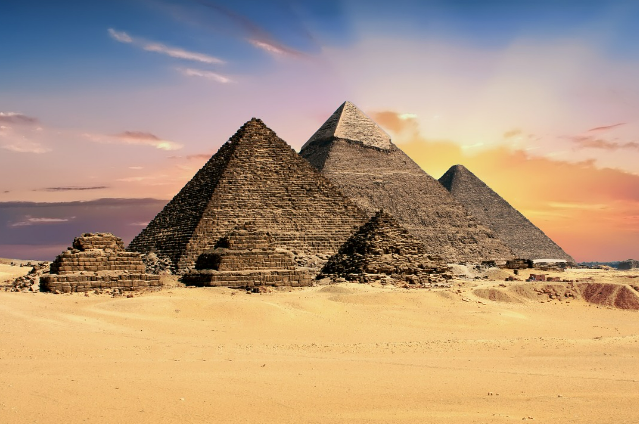
Egypt is one of the world's oldest cities. Ancient Egypt's civilization is not only one of the oldest, but also one of the most advanced civilizations ever. That explains why Egypt's conundrum seems to have no solution. Nearly 3,000 years of world dominance by the Ancient Egyptians resulted in a rich legacy of art, architecture, and mythology. However, despite being extinct for thousands of years, Ancient Egypt also left behind a few puzzles that researchers and archaeologists have yet to fully unravel. Entire story of Egyptians has simultaneously astounded both the public and the archaeological department, including the ancient tombs and countless-year-old temples. Numerous organizations have started a number of investigations to understand more about its mysteries—which are unheard of and unresolved.
Some of the Mystiques of Egypt
Egypt is riddled with secrets and puzzles. The following are some of history's greatest mysteries.
1. How were the pyramids constructed?
The gigantic pyramids of ancient Egypt are one feature of their legacy that has baffled scholars for a very long time. How precisely could a culture without access to modern construction tools move the massive, heavy stones required to construct the gigantic pyramids? Wet sand may hold the key to the solution, according to a recent study by physicists at the University of Amsterdam.
According to study lead author Daniel Bonn, "it turns out that watering Egyptian desert sand can lower the friction by a little, which suggests you need just half the people to pull a sledge over wet sand, compared to dry sand." Further proof that water may have been used in the difficult and intricate process of building the ancient pyramids comes from an antique wall painting that appears to show Egyptians soaking the sand as they dragged a sledge carrying a huge statue.
2. How did King Tut die?
King Tutankhamun was died at the age of 19, and the exact circumstances of his death are unknown. Not because he was in his prime, but rather because his death is a complete mystery. Tut had so many problems that it's difficult to determine which one caused his death, which is why his passing is so mysterious. King Tut's health was atrocious. His parents must have been siblings, according to historians, because he was born with so many hereditary abnormalities and also had malaria. He had a club foot and genetic flaws, which some people think may have made his demise inevitable. Additionally, he had a shattered skull, which archaeologists long assumed indicated that he had been stabbed in the head. Although it is now thought that his head was just broken during the embalming process, the possibility that he was murdered has not been completely discounted. He also suffered a knee injury just before passing away, which has given rise to the belief that he perished in a chariot accident. But even if he was, boarding the chariot in the first place was an odd choice. Tut was unable to even stand unaided due to his extreme deformity. It could have been anything, or a variety of things could have all been affecting him at once. King Tut didn't receive a lot of good news in his final month of life, that much is certain.
3. What is concealed inside the Great Khufu Pyramid?
For Pharaoh Khufu, the greatest pyramid was erected 4,500 years ago. More than 2.3 million stone pieces were used to construct the enormous monument, which is about 150 metres (490 feet) tall. And yet, until recently, it appeared to only have three chambers inside. In order to check for anything they could have missed, a team examined the pyramid in November 2017. Indeed, they discovered evidence that suggested there might be a sizable concealed chamber above the pyramid's Great Gallery that was as massive as the structure's largest room. The odd thing is that the Egyptians made the secret chamber purposefully impossible to enter. No hallways exist. There are no connecting passageways or corridors. They could only have filled the room with something while they were constructing the pyramid and then sealed it later. The subterranean chamber's inside has yet to be revealed. However, Pharaoh Khufu evidently did not want whatever was inside to ever be made public.
Egyptians' Beliefs in Mummy
The Egyptians also believed that the body and soul were important to human existence, in life and in death. Their funerary practices, such as mummification and burial in tombs, were designed to assist the deceased find their way in the afterworld. The tombs were filled with food, tools, domestic wares, treasures -- all the necessities of life -- to ensure the soul's return to the body so that the deceased would live happily ever after.
If wrappings of cloth can impart respectability, the most respectable persons are the Egyptian Mummies, all wrapped in layers and layers of gauze! - Kamala Suraiyya Das
What is Mummy?
Dead Pharaohs (Kings) in Egypt who were preserved after death to become deities worshipped by the populace are known as mummies. Practically, a cadaver whose skin and dried tissue have been preserved by chemical exposure, extreme cold, extremely low humidity, or airlessness, whether on purpose or accidentally, is referred to as a mummy. About 3300 BC is when the earliest "mummy" was discovered. Because of its red hair, this mummy is known as "Ginger" and is kept in the British Museum in London, England. "Ginger" was discovered buried beneath the scorching, dry sand of the desert, which preserved the remains.
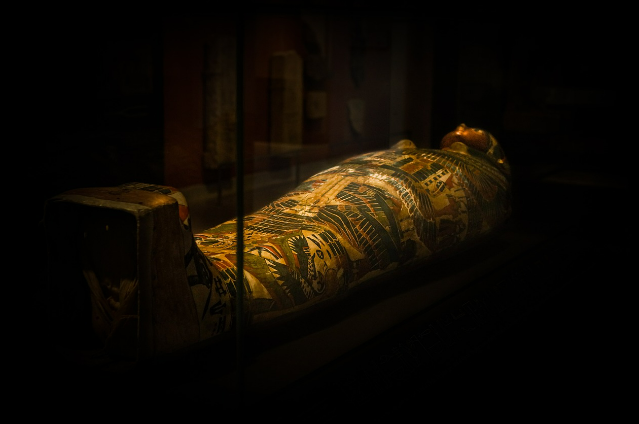
Why did the Egyptians of antiquity make mummies?
Ancient Egyptians believed in life after death, which meant that after passing away, a person travelled to the underworld. They thought that preserving their body was necessary for survival in the hereafter. A mummy is a preserved human body. The body needed to be conserved in order to ensure that the person's spirit and essence—referred to by the Egyptians as "ba" and "ka"—would always have a place to live after death. The Egyptians initially attempted to keep the body intact. But eventually, they understood that they had to take out the internal organs. To hold the organs, they created unique canopic jars. After that, embalmers utilized natural salts to completely dry out the body to make it more difficult for bacteria to colonize it and cause deterioration. The mummies were anointed with oils and scented spices to get them ready for their journey to the afterlife once the corpse had completely dried and all liquid had been removed.
Ancient Egyptian embalmers were actually professionally trained priests because mummification was a process connected to the belief in eternal life. They were adept at working with salts and were aware of the prayers and rituals connected to each stage of the procedure. After the mummification procedure was finished, the mummy was placed in a coffin and had a funerary mask placed over its head that was made to mimic the mummy's actual face. The Ancient Egyptians held that the deceased's "ba" and "ka," or soul and essence, would use the funeral mask to identify its body when the two were reunited in the hereafter. In cases where the deceased was a pharaoh or another person of immense prominence, funeral masks were occasionally crafted of solid gold. The mask was typically fashioned of wood or cartonnage (similar to papier-mâché), which was then painted or plated with gold.
The intelligent mummification process
Egyptians thought that bodies needed to be preserved because of their post-mortem significance. Mummification was a fundamental aspect of Egyptian religion, even though the most complex forms of this practice were exclusively used by the most affluent members of Egyptian society.
A body begins to decay after death. Depriving the tissues of moisture and oxygen is vital to stop a body from decaying. The early Egyptians interred their dead in the desert in little pits. The dead body's moisture was soon drained from it by the hot, dry sand, creating a natural mummy. However, the Egyptians learned that the body would not be preserved if it was first placed in a coffin. The Ancient Egyptians started to create their mummies using a method called mummification to ensure that the body was preserved. The body had to be embalmed before being wrapped in flimsy linen strips.
The mummification method used to create the Egyptian mummies took about 70 days, or 7 weeks; in Egypt, a week was made up of 10 days. The steps were as follows:
- First, the priests bathed the body in the holy River Nile.
- A cut was made on the left side of the abdomen, and the heart, which the Ancient Egyptians believed to be the seat of intelligence and emotion, was left inside the body for use in the judgement that would determine the deceased pharaoh's fate in the afterlife. The internal organs, including the liver, intestines, lungs, and stomach, were all removed from the body. What such a intelligent move?
- The brain was extracted through the nostril using a hooked instrument. The brain was discarded because it was deemed to be unimportant.
- To remove all moisture, kill the bacteria, and prevent the body from rotting, the body and internal organs were sealed in Natron salt for forty days.
- The dried organs were put in Canopic jars after being wrapped in linen. Each jar's lid was fashioned to resemble one of God Horus' four sons.
- The body was washed, and exotic oil extracted from the sacred Louts flower was applied to the dried skin.
- The body was wrapped in rags and sawdust, and the open wounds were wax-sealed. The deceased's body was bandaged with linen. This process took 15 to 20 days and involved about 20 layers.
- To replace the face in the event that the mummy was damaged, a death mask was placed over the bandages that resembles the face of the deceased.
- The shroud was wrapped around the bandaged body and fastened with strips of linen.
- The body was then placed in a painted mummified coffin that was stacked seven coffins high, one inside the other, like a Russian doll.
Mummies of Egypt in Museums
Today, researchers put great effort into preserving both human and animal mummies in specially made cases. The mummies that are most well-known are those of the pharaohs, many of which are now on display in the Cairo Museum. There are more mummies on view in museums all over the world.
There were also more mummies found in caches. Priests gathered the remains of numerous pharaohs and placed them in a single tomb during the 21st Dynasty in order to preserve them. The most well-known of these mass graveyards is the Deir el-Bahri stockpile. Egyptologists discovered 40 royal mummies in this area, including Ramses II. Peasants were selling artefacts from the cache, which led scholars to the stash. Authorities in Egypt located it and took the mummies and all the treasures from it. During their excavation, the excavators made no notes about where the mummies were located in the caves.
The tomb of Amenhotep II:
The tomb of Amenhotep II had yet another trove of royal mummies. Five of the 14 royal mummies, including the pharaoh's body, are still in the tomb. Scholars took the remaining nine bodies of other pharaohs to a museum.
By measuring and analyzing the mummies' skulls, researchers were able to reconstruct the faces of the Egyptian mummies and create portraits of the pharaohs. In order to identify mummies and ascertain whether an illness caused their death, DNA analysis has been employed. This has produced some interesting facts, frequently disproving beliefs and myths.
It was thought that King Tutankhamun and his family were the victims of a murder. He most likely passed away from malaria and an infection in a shattered bone, according to DNA tests. The mother of Tutankhamun was also identified, however her name is unknown.
Two foetal coffins were discovered in King Tutankhamun's tomb. The king's daughters were these two young women. One had a number of illnesses that would have caused her to be malformed. King Tutankhamun's brother was most likely another mummy from KV 55.
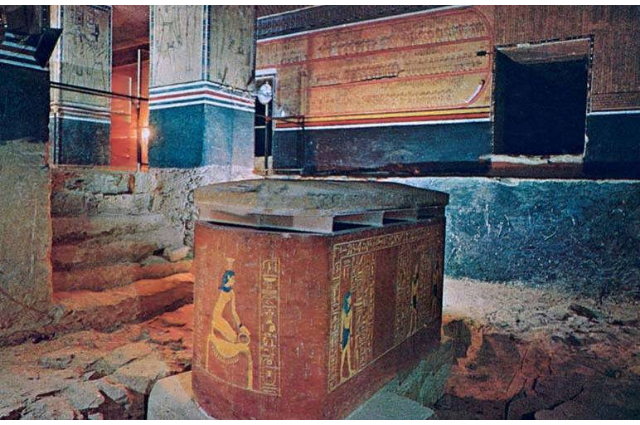
Source: Egypt Nile Cruise
Facts about Egypt mummies
1. The purpose of the Egyptian pyramids was to preserve the kings' mummified remains for future generations.
The pyramids were constructed to keep the dead pharaoh's body safe (king). These enormous tombs were built to resist the passage of time and were meant to last forever. When the king passed away, he symbolized "Osiris," the setting sun, and his son, the new pharaoh, symbolized "Horus," the rising sun. In order to keep the cycle of the sun setting and rising going, it was crucial to retain the bodies of the Dead kings. The pharaoh was buried with his most valued things, including jewellery, funeral statues, and artefacts that would benefit him in the afterlife, after the mummification procedure was complete.
The king's mummy was enclosed in a huge stone sarcophagus in each pyramid, but after they were looted by tomb raiders, the reigning Kings made the decision to erect their tombs among cliffs.
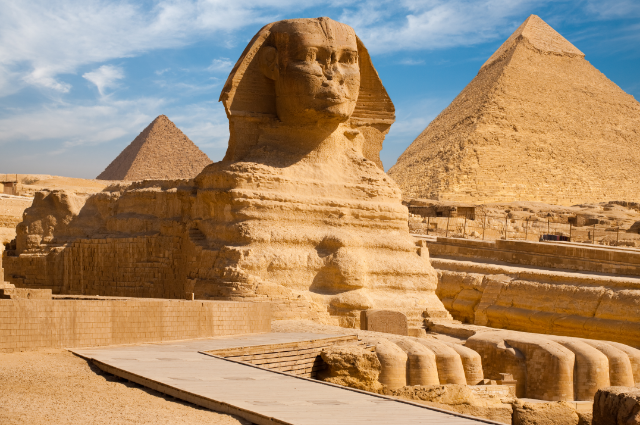
Source: Travel Tips
2. In Egypt, cats were considered to be a very sacred animal, thus when they died, they were also mummified with the kings
Not only the dead Pharaohs (Kings) of Egypt were mummified there. Along with the Kings, other animals—particularly cats—were also mummified. In ancient Egypt, cats were revered as exceedingly sacred creatures and were frequently regarded as the bringers of luck. Additionally, it was widely believed that cats could eliminate pests, including venomous snakes, which is why cats were revered in ancient Egypt. Many Pharaohs had their pet cats mummified and buried with them.
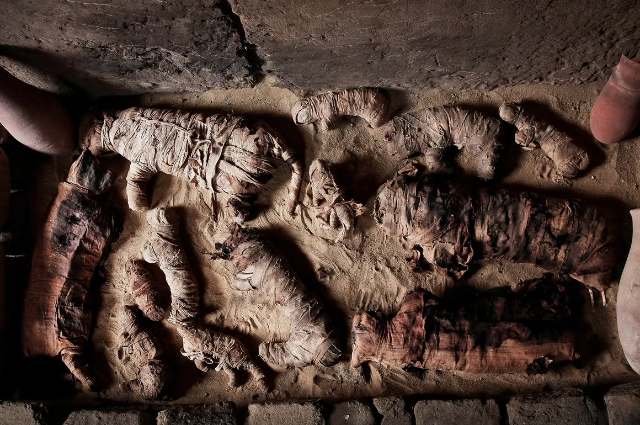
Source: The Independent
3. Curses are believed to have been placed on the mummies to protect them from evil and keep thieves away
When the Arabs first arrived in Egypt in the seventh century, stories of the "Curse of the Pharaohs" began to circulate. It has long been believed that the Mummies were guarded by a curse that would be placed upon anyone who attempted to smuggle them, out of fear that they might be stolen for the antiques that were buried with the Dead Bodies.
Although many rumours about people being cursed have circulated since 1923, when an archaeologist by the name of "Howard Carter" and his excavation backer, Lord Carnarvon, discovered King Tutankhaumum's tomb, no archaeologist has ever been able to pinpoint the curse's origin. Howard Carter passed away in 1939, and Lord Carnarvon later perished from blood poisoning.
Besides Egypt, there are other mummy examples
1. Rosalia Lombardo
In Palermo's Capuchin Catacombs, two-year-old Rosalia Lombardo's mummified remains are interred. She passed away in 1920 due to pneumonia, but her body is remarkably well-preserved. A tiny child sits in an open casket in the depths of a mysterious Sicilian catacomb. Rosalia Lombardo passed away in 1920 at the tragically young age of two as a result of complications from pneumonia. Her father was so distraught that he asked an embalmer to help him preserve his child. Then Alfredo Salafia, the embalmer, mummified Rosalia Lombardo to such a high standard that her internal organs are still in tact today. It is challenging to look at the small body in the glass casket without thinking that she may suddenly awaken. Her golden hair is neatly pulled back behind her with a huge, silk bow, and her skin is still porcelain smooth. And most menacingly, her blonde eyelashes are showing beneath her crystal blue irises.
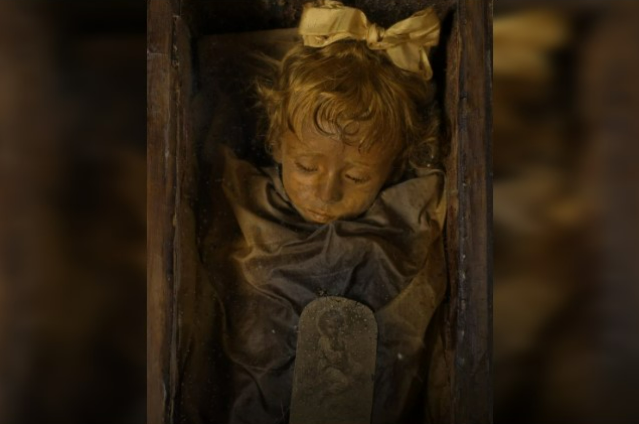
Mummy of Rosalia Lombardo
Source: Wikipedia
2. Unnamed 1,200-year-old mummy
Archaeologists in Peru discover a 1,200-year-old mummy in 2021. Unidentified skeletal remains from a person who was buried between 800 and 1200 AD have been discovered by an excavation team close to the capital of Peru. A mummy believed to be between 800 and 1,200 years old was discovered by a team of archaeologists in Peru near the capital city of Lima. The person's hands were covering their face, and the remains were discovered bound with rope. Although the gender was not determined, it is believed that the remains belong to a guy between the ages of 18 and 22. The search was directed by Yomira Silvia Huaman Santillan and Pieter Van Dalen Luna, two archaeologists from the National University of San Marcos. The key distinguishing feature of the mummy, according to Van Dalen Luna, who also noted that the remains belonged to a person who lived in the country's high Andean region, is that the entire body was bound together by ropes and that the hands were covering the face. A more accurate chronology is not provided yet. At a dig site in Cajamarquilla, east of Lima, the mummy was located in a burial chamber that measured three metres in length and was 1.4 metres deep. The Andean guinea pig and what appears to be a dog remains were also discovered by experts adjacent to the mummies. The grave also included offerings such porcelain, stone tools, and vegetable remains.
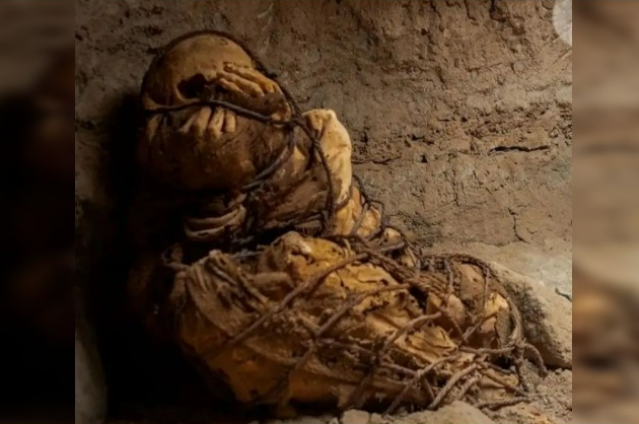
A 1,200-year-old mummy
Source: Wikipedia
Conclusion
Oh, not at all ended. Egyptian archaeologists are still producing significant findings today, and research on royal mummies is illuminating the pharaohs' ancestry in unexpected ways. Numerous concerns regarding the development of Egyptian civilization are being addressed by the continued translation of hieroglyphic writings and research into the lives of the peasants. Although the pharaonic religion suggests that the Egyptians were concerned with death, there are many signs that they were a joyful people who knew how to appreciate life.
. . .
References:
